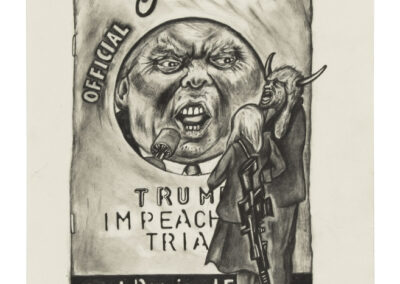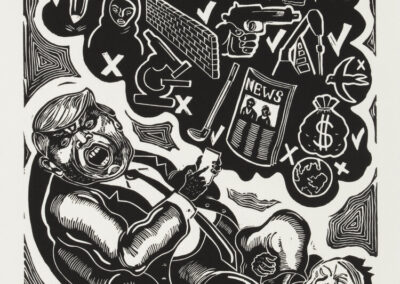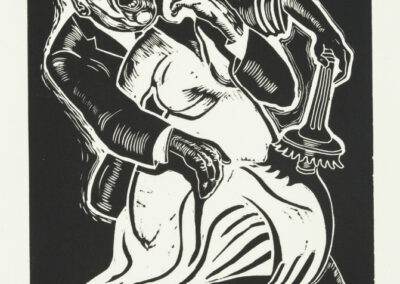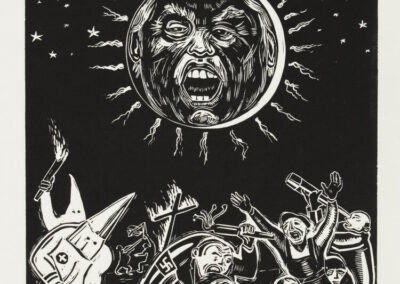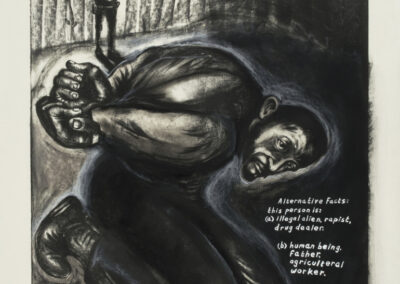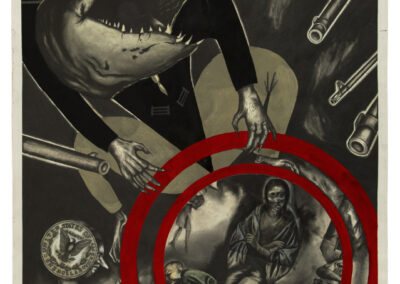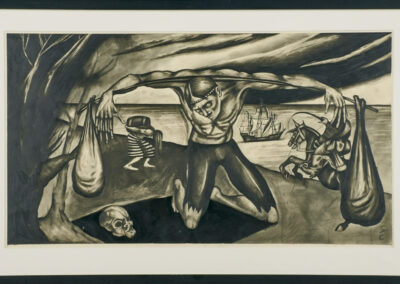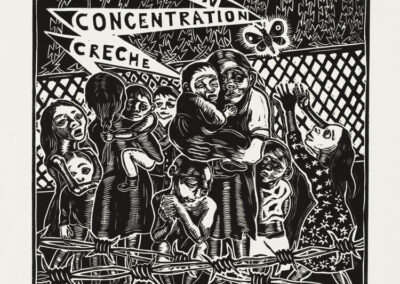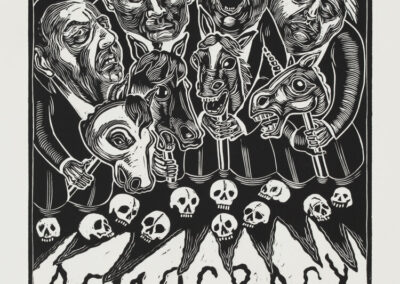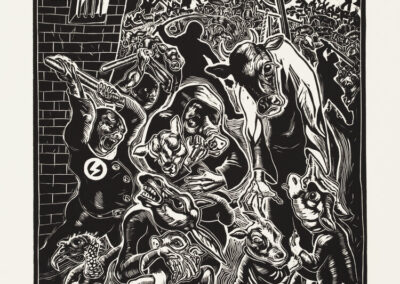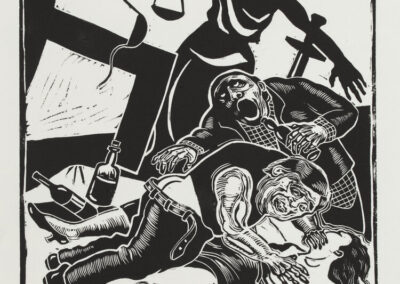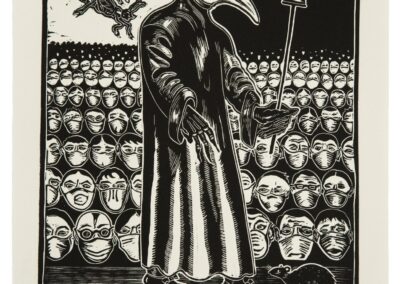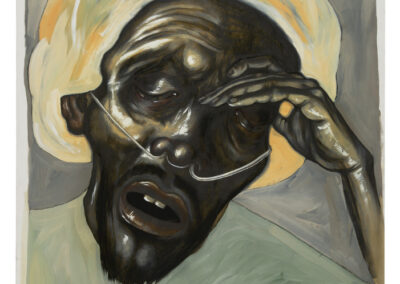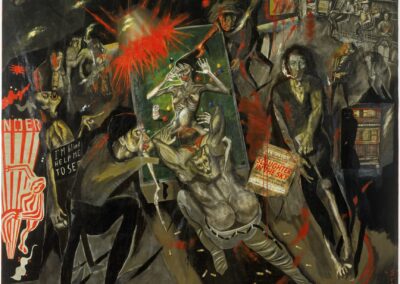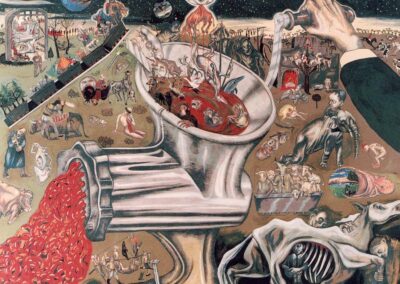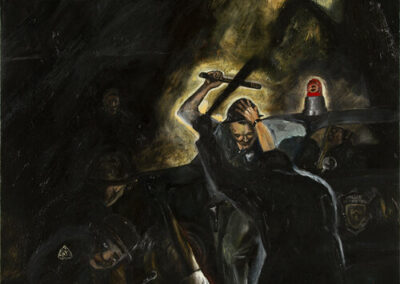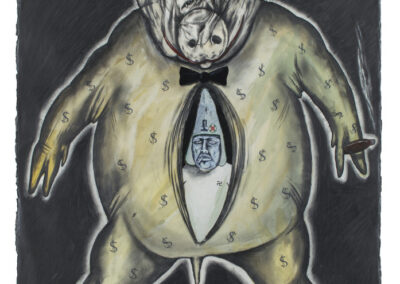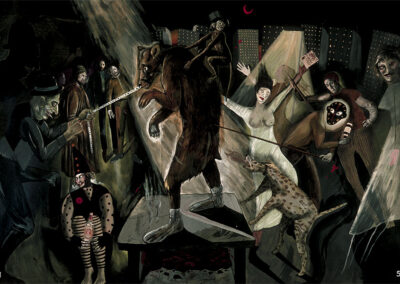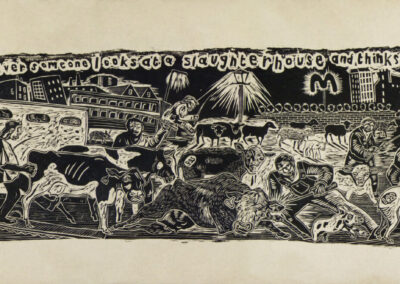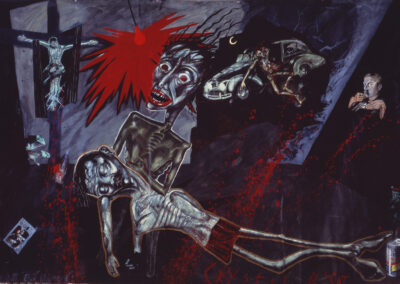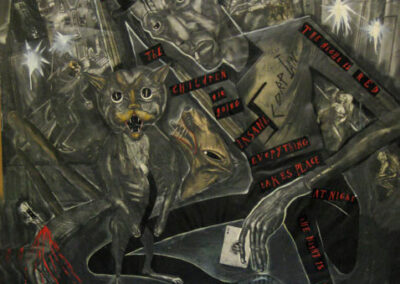Our next Artist You Need To Know is Sue Coe. Her works are unique, viscerally memorable, and she has been described as ‘an activist whose art is a blend of visual journalism, social protest, and propaganda.’ (from here) In many ways, Coe is a successor to a previously featured Artist You Need To Know, Käthe Kollwitz: there is a brutality, a simplicity and an unflinching power to both their bodies of work. ARTFORUM, in featuring her work, stated that “Sue Coe paints horror beautifully, ugliness elegantly, and monstrosity with precise sanity.”
Coe’s words: “I believe in truth based activism. Deteriorating social conditions create the resistance, as well as embolden the extreme right. We are the audience (now defined as product) witnessing the crime of corporate greed and destruction of life. How that impacts me personally, is making the art which slows time down long enough to resist.” (from here)
-

Official Souvenir Guide to the Trump Impeachment Trial, 2021
-

Tweeter in Chief, 2017
-

Unpresidented, 2017
-

Total Eclipse of Rationality, 2017
-

Wheel of Fortune, 2016
-

Alternative Facts, 2017
Coe’s early life left an indelible impression on her, and informed her art practice for her entire career. Born in Staffordshire, England, Coe “grew up near a slaughterhouse, which instilled in the artist a lifelong passion for animal rights activism. This political sensibility characterizes Coe’s work, which often explicitly makes animal rights and other social issues its central subject….Her work is notably influenced by Chaïm Soutine, Käthe Kollwitz, and Francisco de Goya, among others. Along with her investigation of cruelty against animals, Coe has also explored topics such as sweatshops, prisons, AIDS, war, and anticapitalism throughout her work. Her illustrations have appeared in a wide variety of publications, including The New York Times, The New Yorker, and The Nation. She lives and works in upstate New York.” (from here)
-

Homeless Woman Dressed in Garbage Bags, 1992
-

Monetarism, 1987
-

What Central American Democracy?, 1985
Coe graduated from the Chelsea School of Art and Royal College of Art in London before moving to New York. She worked as a teacher before fully devoting herself entirely to her art, often “exploring in each instance the theme of protest against any kind of social or political abuse of power.” While in the United States, she researched both the Dada movement and New Objectivity (which was a dominant style in Germany between 1918 and 1933); both of these were dominated by “politically-conscious works…which tackled society’s failings with revolutionary fervour.” Influenced by these ideas, Coe “developed a sharp and unaffected figurative style, free of any element that would get in the way of the power of the message conveyed, and going so far as to add words or symbols to her drawings to simplify their interpretation.” (from AWARE)
-

American Concentration Creche, 2019
-

Four Horsemen of the Apocalypse, 2019
-

Language of the Dictator, 2019
-

Court Capture (Kavanaugh), 2018
-

Doctor MAGA (or Dr. Maga), 2020
-

Paul, 1994
Coe works primarily in printmaking, as it can “serve a broad audience, disseminating her messages through affordably-priced prints accessible to people of all financial means.” She has also often worked in book format, producing many publications over her career, all acting as political and social critiques. Several notable works: Bully: Master of the Global Merry-Go-Round (2004) which was a visual indictment of the Bush administration in the United States, and Sheep of Fools: A Song Cycle for Five Voices (2005), which revisited Coe’s them of animal abuse in farming (sheep, in this case). Other notable print / book works include How to Commit Suicide in South Africa (1983), X (1986), Police State (1987), Pit’s Letter (2000), and The Ghosts of our Meat (2013).
-

Woman Walks into Bar - Is Raped by Four Men on the Pool Table - While 20 Watch, Sue Coe, 1983
-

Second Millennium, 1988
-

Police State, 1986
-

Traffic Violation, 1986
-

Reagan Speaks for Himself, 1984
-

Begging Dog, 1986
Sue Coe has been awarded a number of significant honours. She received the Dickinson College Arts Award in Carlisle (2013), a Lifetime Achievement Award from the Women’s Caucus for Art (2015), and a Lifetime Achievement in Printmaking Award by The Southern Graphics Council in Atlanta, Georgia (2017). A fine article about her works can also be read here, which praises Coe for “expanding on a legacy inherited from George Grosz and Otto Dix” in taking “political and psychological art to new depths” of a “world where the fragile and the disenfranchised of both the human and the animal kingdom are all in great peril.”
-

Bear, n.d
-

Auschwitz Begins..., 2009
-

Breaking, 1984
-

Crystal Night, 1984
-

The Children Are Going Insane, 1983
-

Riot, 1984
Since 2016, Coe has produced numerous works that are a visual history of the “the misdeeds of the Trump administration and, more recently, its failure to adequately address COVID-19.” (from her site) “Art and design, if it is linked to mass struggle can be highly effective. You can’t have a political art uncoupled from political struggle. The ruling class are attempting to silence dissent, by blaming the victims. It’s the oldest trick in the book, along with divide and conquer. Art is a positive non-violent way people can speak to each other across walls and borders.” (from an interview with Coe that can be read here)
Sue Coe’s own site is necessary to include here, as not only does it have many more of her images, but several essays and other writings by the artist that offer a more complete – if somewhat more harrowing, than hopeful – overview of her art and politics (Coe might say that they are one and the same).
Her site can be explored here.

